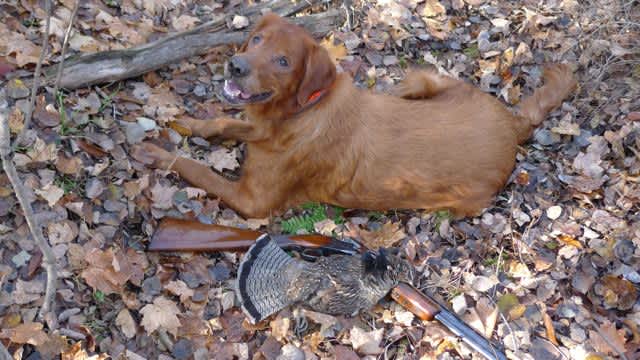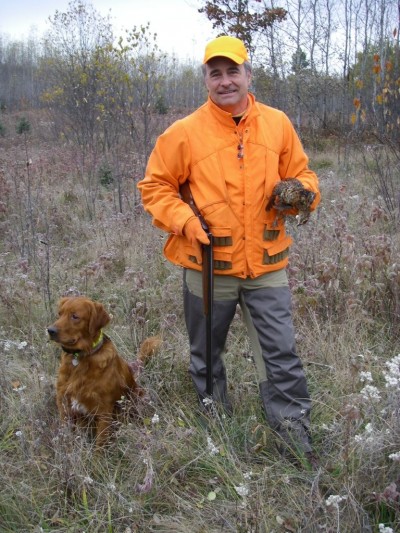Revisiting a Tradition: Michigan Grouse Hunting Season Opens
Dave Mull 09.15.13

For many Michigan hunters, the September 15 opening of grouse season is the second-most anticipated day of the year. The most anticipated date takes place two to three weeks later when the leaves start falling and we start deer hunting.
This year, according to the Michigan Department of Natural Resources, the population is on a downward trend in the birds’ 10-year cycle, but the hunting still should be pretty good, especially in the Upper Peninsula. Using data from 87 routes run in 2012 and 2013, statewide there was a 10.3 percent decrease in the average number of drums heard per route between 2012 (11.8) and 2013 (10.6). The drumming counts were highest in Zone 1, which encompasses the U.P.—route tab takers heard an average of 14.5 drums per route This was followed by Zone 2, constituting roughly the northern half of the Lower Peninnsula, where 9.4 drums were heard. The southern part of the Lower Peninsula averaged 6.4 drums per route.
About 10 of my buddies and I convene for our annual Lady Macbeth Memorial Grouse and Woodcock Camp (named in honor of its founder’s late English setter) above the Mackinac Bridge, and we’ve just completed all the meal planning and other preparations for the week-long stay in bird-hunting heaven.
Of all outdoor pursuits, there is nothing more satisfying for us than following dogs through thick brush, watching them catch scent, and quickly figuring out where we can stand so the shotgun barrel won’t whack one of the spindly aspen trunks that abound where we usually find birds. Adrenaline rushes as a grouse thunders into the air. Shotguns blast and more often than not, the bird lives to have a better day. Although we have a couple of dead-eye shots, most of us have perfected the art of “shoot-and-release.”
Preparation for camp isn’t as complicated as it once was. Our tradition started around 1985, with Michigan’s well-known upland bird writer Tom Huggler and a couple friends setting tents in primitive state campgrounds. It soon grew to a core group of 10 guys, mostly writers and photographers. Back then, September preparations meant making sure our tents were free of mildew and had all the stakes and support poles. We aired out sleeping bags, found our Coleman stoves and lanterns, and rounded up the rest of our camping gear. That lasted for almost 20 years until one night while we all tried to stay warm around the campfire, someone mentioned how much easier it would be for us if we rented a lodge.

The debate didn’t last long, and we’ve rented three different ones over the last seven years, from Lake Gogebic to Little Bay de Noc, pleasantly surprised at how inexpensively we could rent lodging in this period between the summer fishing season and firearm deer season when the proprietors were eager for business. All three of the places have been top-notch and dog-friendly. The first time we stayed in such comfort, a small contingent lobbied to return to primitive campgrounds, but that lunacy was soon quelled. We pretend we go the lodge route because we’re older and more prosperous, but the truth is we’re just older.
Nowadays, the preparation checklist is a lot simpler. Guns and ammo (most of us shoot 20 and 28 gauge shotguns, No. 7-1/2 or No. 8 shot for loads). Hunting togs. Blaze orange vest. Dog food. Dog and human first aid kit. Adult beverages.
Each morning we split off into groups of two to four guys, driving off after morning coffee towards coverts we have marked in our Michigan Gazetteers with names that reflect how good the hunting was or something that occurred there. These include “The Judas Grouse,” “The Golden Triangle,” “The Butthead RVer,” and “The Promised Land.” Each dated mark on the map has numbers of bird flushes versus kills. After a morning hunt we lunch in the woods or at a small-town café, then chase the dogs again. We get back to the lodge for a huge dinner, prepared by assigned cooking teams. One of our number, Steve Tracey, is a hobbyist gourmet chef, and he and camp founder Huggler usually make the final night’s meal. They often prepare game that Huggler has harvested on an early season trip (Alaskan ptarmigan in a heavy sherry-cream sauce is embedded in my memory) complemented by dishes made of our own woodland harvest. Woodcock breast rumaki (without the chestnut) sizzled on the grill to make the bacon wrap crispy but leaving the breast meat rare. Grouse breast medallions, lightly breaded and pan-fried in butter. Male competitiveness used to spur the rest of us to try and outdo Tracey and Huggler’s upcoming feast, but in recent years, we’ve given up and lowered the bar, serving spaghetti, pork tenderloins, or gumbos. Not many items on our menus would be included in a doctor-prescribed healthy diet.
To be sure, good shots get plenty of accolades, but grouse hunting isn’t about getting a limit of birds for us. It’s about learning new coverts, following dogs to where the birds hang out, and enjoying each other’s company.
For more information on Michigan hunting go to michigan.org. Click here to purchase a Michigan hunting license online.

